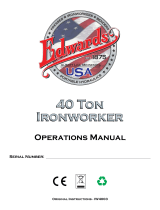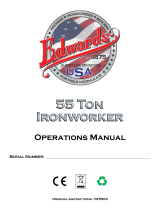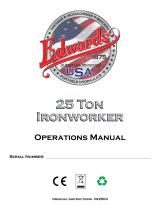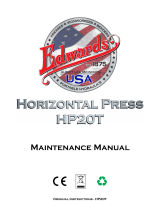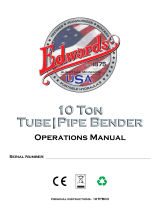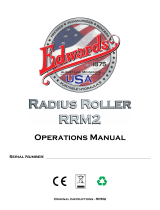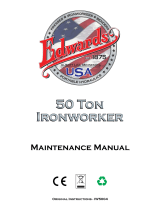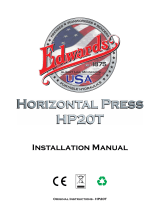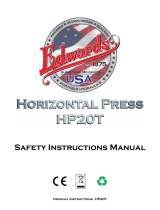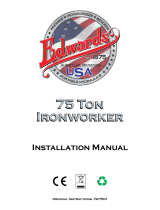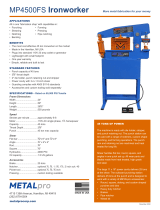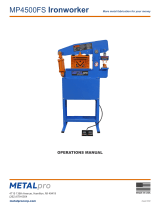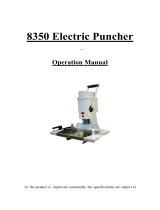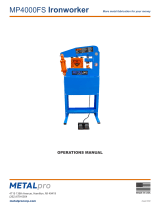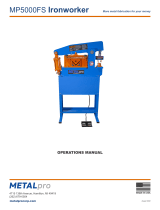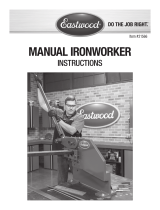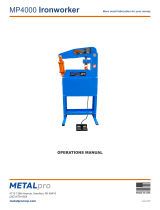Page is loading ...

Operations Manual
Original Instructions - IW6503
Serial Number:

1
1 General
Declarations of Conformity
Company Prole
Warranty
Machine Identication
Operator and Supervisor Information
Signal Word Denition
Signal Word Panel
Operational Precautions
Machine Operations
Foreseeable Misuse
Machine Life Cycle
6 Operations Diagrams
10 Control Panel
11 Angle Shear Station
Safe Operation
Angle Shear Operation
12 Bar Shear Station
Safe Operation
Bar Shear Operation
13 Electric Stroke Control
Setup
Safe Operation
Electric Stroke Control Operation
14 Punch Station
Setup
Safe Operation
Punch Operation
Punch and Die Operating Clearances
Punch Capacities
Material Multiplier
Punch Tonnage Requirements (Figure 1)
16 Notcher Station
(50/60/65/75/100DX/120 Ton Ironworkers)
Safe Operation
Notcher Operation
Optional Tooling
17 Angle Notcher
18 Auto-Cut Tool
19 Brake
20 Notcher (25/40/55/100Ton)
22 Oversize Punch
23 Pipe Notcher
24 Rod Shear/Multi-Shear
25 241 Punch
26 Accessory Light
27 Hydraulic Accessory Package
28 Troubleshooting
Operations Manual Table of Contents Declarations of Conformity
EU DECLARATION OF CONFORMITY WITH COUNCIL DIRECTIVE 2006/42/EC
Date of Issue: 01/11/2013
Directive:
Machinery Safety Directive 2006/42/EC
Electromagnetic Compatibility Directive 2004/108/EEC
Low Voltage Directive 2006/95/ES
Conforming Machinery: Model: 65 Ton
Type: Hydraulic Punching Machine
Serial Number: Refer to Title Page
Manufacturer: Edwards Manufacturing Company
1107 Sykes Street
Albert Lea, MN 56007
USA
Person Authorized to compile the
Technical File Established in the EU
Julian Smith and Melanie Smith – Directors
Alpha Punch & Machinery Ltd
Unit 7 Binder Industrial Park
Eland Road
Denaby, Doncaster DN12 4HA
UK
Tel: 011-441709866083
Fax: 011-441709866356
Harmonised Standards
Referenced or Applied:
EN 13857:2008, EN ISO 13850:2008, EN 60204-1:2006+A1:2009/AC 2010, EN 12100:2010, EN 349:1993+A1:2008, EN 953:1997
+A1:2009, EN 1037:1995+A1:2008, EN 614-1:2006+A1:2009, EN ISO 4413:2010, BS EN 13849-1:2006
Specications with which Conformity is
Declared: Essential Health and Safety Requirements of Annex 1 of the Machinery Directive
We hereby certify that the machinery described above conforms with the essential health and safety requirements of Council Directive 2006/42/EC on the approximation of the laws of the
Member States relating to the safety of machinery.
Signed:
Signatory: Printed Name : Douglas L. Friend
Title: Chief Operating Ofcer
Technical File Reference Number SF11987A1.EMC
Notes Concerning Harmonized Standards Referenced or applied:
EN ISO 13857:2008 Safety of machinery. Safety distances to prevent hazard zones being reached by upper and lower limbs.
EN ISO 13850:2007 Safety of machinery — Emergency stop — Principles for design
EN 60204-1:2006+A1:2009/AC 2010 Safety of machinery. Electrical equipment of machines.
General requirements.
EN 349:1993+A1:2008 Safety of machinery. Minimum gaps to avoid crushing of parts of the human body.
EN 953:1997 +A1:2009 Safety of machinery. Guards. General requirements for the design and construction of xed and movable guards.
EN 1037:1995+A1:2008 Safety of machinery. Prevention of unexpected start-up
EN 12100:2010 Safety of Machinery – General Principles for design –
Risk Assessment and risk reduction.
EN 614-1:2006+A1:2009 Safety of machinery — Ergonomic design principles —.
Part 1: Terminology and general principles.
EN ISO 4413:2010 Hydraulic uid power - General rules and safety requirements for systems and their components
BS EN 13849-1:2006 Safety of machinery. Safety related parts of control systems. General principles for design

23
DECLARATION OF NOISE EMISSION Sound Pressure and Sound Levels per EN ISO 1102
Date of Issue: 01/11/2013
Machinery:
Model: 65 Ton
Type: Hydraulic Punching Machine
Serial Number: Refer to Title Page
Operating Idle
LpAm (Operator Position) 84 dB (A) 43 dB (A)
LpAm (Bystander Position) 81 dB (A) 41 dB (A)
Peak C-weighted instantaneous SPL in the Operator’s position LpCpeak 95 dB (C) ---
Sound power emitted where the equivalent continuous A-weighted SPL exceeds 80 dB (A). 8.4 Bel ---
The average difference between the extraneous noise level and the sound intensity level at each measuring point is: LpAm Δ = 41 dB (A)
Ambient Correction Factor K3A calculated according to EN ISO 11204 Appendix A. 4 dB( A)
Measurements were made at a height of 1.5 m and 1 m from the Operator Position and all four sides of the equipment.
The gures quoted are emission levels and are not necessarily safe working levels. While there is a correlation between the emission and exposure levels this cannot be used reliably to
determine whether or not further precautions are required.
Factors that inuence the actual level of exposure of the workforce include characteristics of the work room, the other sources of noise, etc. such as the number of machines and other
adjacent processes. Also, the permissible level of exposure can vary from country to country.
This information, however, will enable the user of the machine to make a better evaluation of the hazard and risk.
Edwards Manufacturing Company 1107 Sykes Street Albert Lea, MN 56007 USA
Declaration of Conformity with ANSI / ISO / NFPA / OSHA Standards relating to the Manufacture of Ironworking Machinery
Date of Issue: 12/05/2013
Applicable Standards: ANSI / ISO / NFPA / OSHA
Conforming Machinery: Model: 65 Ton
Type: Hydraulic Punching Machine
Serial Number: Refer to Title Page
Manufacturer: Edwards Manufacturing Company
1107 Sykes Street
Albert Lea, MN 56007, USA
Harmonised Standards
Referenced or Applied:
ANSI B11.05, ANSI B11.0, ANSI B11.19, ANSI / ASSE Z244.1, ANSI Z535.2, ANSI Z535.3, ANSI Z535.4, ANSI Z535.5, ANSI / ISO 12100, ISO
13849-1, NFPA 79, OSHA1910.147, OSHA1910.212, OSHA1910.219
We hereby certify that the machinery described above conforms with the essential health and safety requirements of Council Directive 2006/42/EC on the approximation of the laws of the
Member States relating to the safety of machinery.
Signed:
Signatory: Printed Name : Douglas L. Friend
Title: Chief Operating Ofcer
Technical File Reference Number SF11987A1.EMC
Notes Concerning Harmonized Standards Referenced or applied:
ANSI B11.05 1988 (R2008) Ironworkers - Safety Requirements for Construction, Care and Use
ANSI B11.0 2010 Safety of Machinery - General requirements and Risk Assessment
ANSI B11.19 Performance Criteria for Safeguarding
ANSI / ASSE Z244.1 2003 (R2008) Control of Hazardous Energy - Lockout / Tagout and Alternate Methods
ANSI Z535.2 2011 Environmental and Facility Safety Signs
ANSI Z535.3 2011 Criteria for Safety Symbols
ANSI Z535.4 2011 Product Safety Signs and Labels
ANSI Z535.6 2011 Product Safety Information in Product Manuals, Instructions, and Other Collateral Materials
ANSI / ISO 12100 Safety of Machinery - General Principles for design - Risk Assessment and risk reduction.
ISO 13849-1 Safety of machinery. Safety related parts of control systems. General principles for design.
NFPA 79 2012 Electrical Standards for Industrial Machinery
OSHA1910.147 1989 The Control of Hazardous Energy (Lockout / Tagout)
OSHA1910.212 1971 General Requirements for all Machines
OSHA1910.219 1971 Mechanical Power Transmission Apparatus
Company Profile
Edwards Manufacturing
Company manufactures
a full line of high quality,
low maintenance hydraulic
ironworking machines, associated
tooling and accessories that are used in the
steel fabrication industry. With proper operation, care,
and maintenance, your Edwards Ironworker or Hydraulic
Accessory Tool will provide years of safe, trouble-free
service. Please take time to study this Operator’s Manual carefully
to fully understand Ironworker and Hydraulic Accessory Tool safety
procedures, set-up, operation, care, maintenance, troubleshooting
and warranty coverage prior to putting the machine into production.
Any questions not answered within this manual can be directed
to your local Edwards Ironworker dealer or factory representative.
Contact the factory:
Edwards Manufacturing
Company
1107 Sykes Street
Albert Lea, MN 56007
507 373 8206 PHONE
507 373 9433 FAX
www.edwardsironworkers.com
General Questions:
sales@edwardsmfg.us
Service Questions:
Contact your dealer:
Warranty
Edwards Manufacturing Company will, within one (1) year
of date of original purchase (proof of purchase required),
replace F.O.B. the factory, any goods, excluding punches,
dies and shear blades, which are defective in materials or
workmanship provided that the buyer return the defective
goods, freight pre-paid, to the seller, which shall be the
buyer’s sole and exclusive remedy for the defective goods.
Hydraulic components are subject to their manufacturer’s
warranty.
Edwards Manufacturing Company will, within thirty (30) days
of date of original purchase (proof of purchase required),
replace F.O.B. the factory, any punches, dies and/or shear
blades, which are defective in materials or workmanship.
This warranty does not apply to machines and/or components
which have been altered, changed or modied in any way,
or subjected to abusive and abnormal use, inadequate
maintenance and lubrication, or subjected to use beyond
seller recommended capacities and specications. Edwards
Manufacturing Company shall not be liable for labor costs
expended on such goods or consequential damages.
Edwards Manufacturing Company shall not be liable to
the purchaser or any other person for loss, down-time, or
damage directly or indirectly arising from the use of the
goods or from any other cause. No ofcer, employee, or
agent of Edwards Manufacturing Company is authorized to
make any oral representations or warranty of tness or to
waive any of the foregoing terms and none shall be binding
on Edwards Manufacturing Company.
Machine Identification
Your Edwards Ironworker has been serialized for quality control, product
traceability and warranty enforcement. Please refer to the aluminum
identication tag with engraved serial number, electrical and power
specications when ordering parts or ling a warranty claim.

45
This is one of four manuals supplied with your machine.
• Installation Manual
• Safety Instructions Manual
• Operations Manual
• Maintenance Manual
READ ALL MANUALS BEFORE OPERATING MACHINERY. Operating
machinery before reading and understanding the contents of all four
manuals greatly increases the risk of injury.
Each of the four machine manuals describe ‘best practices’ in handling,
installing, operating and maintaining your machine. The contents of
each manual is subject to change without notice due to improvements
in the machinery or changes in National or International standards.
All rights reserved. Reproduction of this manual in any form, in whole or
in part, is not permitted without the written consent of Edwards Manu-
facturing Company.
Keep all manuals close to the machine to allow for easy reference when
necessary.
Provide operators with sufcient training and education in the basic
functions of the machine prior to machine operation.
Do not allow for operation of the machine by unqualied personnel.
Edwards Manufacturing Company is not liable for accidents arising from
unskilled, untrained operation.
Do not modify or change the machine without written authorization from
Edwards Manufacturing Company. Unauthorized modication to a ma-
chine may result in serious operator injury, machine damage and will
void your machine warranty.
Never leave a powered machine unattended. Turn machinery OFF be-
fore walking away.
This machine is manufactured for use by able bodied and able minded
operators only. Never operate machinery when tired or under the inu-
ence of drugs or alcohol.
Do not resell, relocate or export to a destination other than to the original
point of sale. Edwards has designed this machine to meet the stan-
dards of the original receiving country and is not liable for meeting any
governing body or performance standards beyond those of the original
receiving country.
Indicates a hazardous situation that, if not avoided,
will result in death or serious injury.
Indicates a hazardous situation that, if not avoided,
could result in death or serious injury.
Indicates a hazardous situation that, if not avoided,
could result in mild or moderate injury.
Indicates information considered important, but not
hazard related.
Signal Word Panel on Machine
Critical machine safety information is identied on signal word labels. La-
bels are attached adjacent to the potentially hazardous locations of the
machine. Reference the Safety Instruction Manual for additional informa-
tion regarding the potentially hazardous condition identied on the label.
Review ALL labels on the machinery, reference the Safety Instruc-
tions Manual, the operational precautions and the safe operations
sections within this manual before any operation activity is initiated.
Failure to read and understand the signal word labels afxed to the
machinery may result in operator death or injury.
Signal Word DefinitionOperator and Supervisor
Information
Edwards Ironworkers are designed to punch, shear and notch mild
steel plate, barstock and angle. A wide range of accessories are avail-
able to fabricate rod and square stock, sheet metal and pipe. Edwards
Ironworkers operate by applying hydraulic force to a moving center.
The center moves within a frame in a simple, vertical path and exerts
force through shear blades, punch and dies, notchers, brake dies
or bump-die tooling upon A36 mild steel. Edwards Ironworkers are
designed for single operator use only; unless otherwise identied with
a D.O./Dual Operator designation.
The following pages detail the proper operations procedures for
setting up and safely operating the standard and optional tooling
of your Edwards Ironworker.
Foreseeable Misuse
Do not use this equipment for any purpose not described in this
manual. Using this equipment in ways not described in this manual
could result in death or serious injury to the operator.
Machine Life Cycle
Edwards Ironworkers are designed to be generally free from risk
throughout their life cycle from installation to dismantling and dis-
posal. Consult your local governmental agency for guidelines and pro-
cedures to ensure the safe disposal and recycling of system hydrau-
lics, electronics and metals.
Reasonable, common sense safety precautions should be observed when
operating the Ironworker or hydraulic accessory tool. The following pre-
cautions are described in order of their hazard.
Electrical Hazard
Dangerous high voltages are present inside the electrical enclosure
of this product. Only qualied, authorized, maintenance or service
personnel should gain access to the electrical panel.
Lockout Power
Danger, circuits are live. Lockout / tagout upstream power source
before any maintenance activity is performed.
Shear / Crush Hazard
Moving parts can cut and crush. Keep hands clear when servicing
and maintaining the Ironworker.
Hydraulic Fluid Hazard
Hydraulic hoses are under pressure. Pressurized uid can pierce
skin and cause severe injury. To avoid physical hazard, always wear
personal protective equipment when servicing / maintaining the
Ironworker.
Do Not Operate With Guard Removed
Physical barriers and guards have been designed and installed to
protect the operator from moving parts that can pinch, cut and
crush. If it is necessary to remove guarding when servicing the
Ironworker, immediately replace guards after service and prior to
power being restored to the machinery.
Refer to Manuals
For safe installation, operation and maintenance of the machine,
read:
Installation Manual
Safety Instructions Manual
Operations Manual
Maintenance Manual
Wear Personal Protective Equipment
To avoid physical hazard wear protective eyewear, clothing, gloves,
footwear, head-gear and hearing protection.
Operational Precautions Machine Operations

67
Angle Shear
Station
Control Panel
Punch Station
Operations Diagram • Machine Front
Foot Pedal
Grease Daily Grease Daily Grease Daily Grease Daily
Coper Notcher
Station
Front Cylinder
Guard
Grease Daily
8 Locations
Operations Diagram • Machine Back
Angle Shear Station
Rear Drop Off
Rear Cylinder
Guard
Flat Bar Shear
Rear Drop Off
Open Tooling
Cavity
Flat Bar Shear
Station

89
Operations Diagram • Machine Right
Coper Notcher
Station
Rear Motor Cover
Operations Diagram • Machine Left
Punch Station
Electric Stroke
Control
Optional Hydraulic
Accessory Pack

10 11
Edwards JAWS Ironworkers feature a centrally located, integrated Con-
trol Panel. Hazardous voltage is present within the control panel.
The panel should only be opened and serviced by authorized personnel.
An external power source enters this panel and is distributed to the vari-
ous working components of the machine.
Push to Start
This button energizes the machine. When energized this recessed but-
ton is internally illuminated and will glow green. If the machine does
not start when pressed an emergency palm stop button may have been
previously pressed and will need to be reset to allow for the start button
to energize the machine.
Emergency Palm Stop
This button de-energizes the machine and contains a manual, safety
reset function. The projecting, red, palm stop style button is set within a
safety yellow bezel and is pushed to de-energize the machinery. Once
de-energized the machine requires the palm stop to be re-set prior to
energizing the machine. Simply rotate the emergency palm stop button
clockwise. The button will retract and the machine will be available for
powered operation.
Operations Control
This three-position switch allows the ironworker operation to shuttle be-
tween Ironworker, hydraulic accessory or auto-cut mode.
Ironworker
Power the Ironworker by rotating the three position switch counter-
clockwise. This function allows for operations of the Ironworker only.
Accessory
Power your Edwards hydraulic accessory tools by rotating the three
position switch to the vertical position. This function allows for opera-
tions of Edwards hydraulic accessories only. The four, female, M12 plug
connections coordinate with accessory controls when power is shifted
from the Ironworker operation to Hydraulic Accessory tool operation. An
additional M12 connection allows for an optional, auxiliary light.
Auto-cut
Power the Auto-Cut operation by rotating the three position switch clock-
wise. This function allows for operations of the Auto-Cut function only.
Lockout/Tagout
This round, safety red switch is set within a square, safety yellow
housing. The switch allows for proper procedures to be followed
when de-energizing, isolating, and ensuring the energy isolation of
the Ironworker. The Lockout/Tagout switch is used, in conjunction with
Owner safety and maintenance programs to ensure that equipment and
machinery is de-energized and isolated from unexpected start-up by
physically locking machinery in a state of zero energy.
To lockout the Ironworker turn the red switch counterclockwise until
the black tagout bar is horizontal. Pull the black, spring-loaded tagout
mechanism to install the maintenance/safety lock and tag provided by
the Owner of the machinery. The machine is now de-energized and is
available for authorized personnel to maintain and service the machinery.
To open the control panel for servicing, gently pull the ‘hopper-style’
hinged cover. The cover will not open fully until a safety yellow thumb
slide located within the safety yellow housing is rotated clockwise.
Reverse operation following service to resume Ironworking.
Control Panel Angle Shear Station
Your Ironworker may include an angle iron shear as a standard fea-
ture. The angle shear will provide a distortion and burr free shear
cut to mild steel angle stock as listed in the Ironworker Speci-
cations as well as described on the capacity labels positioned
at the Angle Shearing Station. The Angle Shearing Station on the
Edwards Ironworker allows for straight cutting applications. An
oversized material hold down adjusts with a simple thumb crank
to safely restrain the material being cut.
Integrated angle shears are factory tuned to proper clearances and
are ready to begin shearing operations. [Shear blades are wear-
ing parts and will need to be maintained or replaced over time.
Refer to Maintenance Manual for blade maintenance, removal and
replacement.]
Safe Operation
Observe the following guidelines when operating the Angle Shear
Station:
• Never exceed the capacities of the machine or tooling as described
in the Ironworker Specications or listed at the tooling station.
• Check shear blade clearance at every tooling change or extended
shear operation. Maintain proper operating clearance at bar shear
and angle shear stations. Refer to Maintenance Manual for tol-
erance adjustment instructions. Failure to maintain clearance will
damage shear blades and support brackets.
• Fully engage the material hold-down with the material being cut.
• Do not stack material to cut in the shear station.
• Perform complete shear operations only – partial shear cuts may
jam the drop off side of the frame and could result in breakage and
operator injury.
• Do not shear angle smaller than the hold-down will accommodate.
Angle Shear Operation
1. Clear shear station of any tools or debris prior to powering the
machine on.
2. Turn machine on. The shear blades will be in their neutral position.
Place angle iron into the material hold-down and position your cut
mark adjacent to the moving shear blade.
3. Secure the angle iron in the material hold-down by engaging the
handscrew into the material.
4. Clear your hands from the working area and depress the foot pedal
to activate the shear station.
5. When the cut is complete, release the foot pedal to automatically
return the shear blades to their neutral position. If equipped with
the hydraulic hold-down feature, the hold-down will retract when
pressure on the foot pedal is released at the end of the cut cycle.
6. Reverse the thumb screw to raise the material hold-down and
remove your material.

12 13
Your Ironworker may include a bar shear as a standard feature.
The bar shear will provide a distortion and burr free shear cut
to mild steel bar stock as listed in the Ironworker Specications
as well as described on the capacity labels positioned at the Bar
Shear Station. The Bar Shear allows for straight or angled cutting
operations. The material hold down adjusts with a simple hand
crank to safely restrain the material being cut.
Bar shears are factory tuned to proper clearances and are ready to
begin shearing operations.
Shear blades are wearing parts and will need to be maintained
or replaced over time. Refer to the Maintenance Manual for blade
maintenance, removal and replacement.
Safe Operation
Observe the following guidelines when operating the Bar Shear Station:
• Never exceed the capacities of the machine or tooling as described
in the Ironworker specications or listed at the tooling station.
• Maintain correct operating clearance at bar shear and angle shear
stations. Refer to the Maintenance Manual for tolerance adjust-
ment instructions. Failure to maintain proper blade clearance will
damage shear blades and shear blade support.
• Fully engage the material hold-down with the material being cut.
• Do not stack material to cut in the shear station.
• Perform complete shear operations only – partial shear cuts may
jam the drop off side of the frame and could result in breakage and
operator injury.
• Use shearing aids when working with small items at the shear sta-
tion.
Bar Shear Operation
1. Clear bar shear station of any tools or debris prior to powering the
machine on.
2. Turn machine on. The shear blades will be in their neutral position.
Place bar stock on the feed table and push the material under the
material hold-down. Position your desired cut mark adjacent to the
moving shear blade.
3. Secure the bar stock in the material hold-down by engaging the
handscrew into the material.
4. Clear your hands from the working area and depress the foot pedal
to activate the shear station.
5. When the cut is complete, release the foot pedal to automatically
return the shear blades to their neutral position. Reverse the hand
screw to raise the manual material hold-down and remove your
material.
Bar Shear Station
Electric stroke control is standard on all Ironworker models with
the exception of the 25 Ton Ironworker. Stroke control enables the
Ironworker operator to shorten up and down stroke with minor
adjustment of two hand screws. Utilize stroke control for precision
bending with your brake tooling, when using embossing or bump
dies or to simply increase production from your punch, notch or
shear stations.
Setup
Electric Stroke control is factory installed and arrives fully set up for
immediate use.
Safe Operation
Observe the following guidelines when using and adjusting the electric
stroke control function.
• Read, understand and follow punching, notching and shearing tol-
erances as described in related chapters of this manual.
• Never exceed the capacities of the machine or tooling as described
in the Ironworker specications or listed at the tooling station.
• Keep limit switches free of dirt and grime.
• Never remove stroke retention nuts from factory setting.
• Never reverse stroke limit switches.
• Conrm that red light is illuminated. If not illuminated, machine
cyle is not complete and potential heat build-up may occur.
Electric Stroke Control Operation
Set upstroke for rapid cycling of your punching, shearing and
notching stations.
1. Power machine on and use the jog function of your electric foot
pedal to bring tooling down to rest just above the material being
worked.
2. Turn machine off.
3. Adjust upper handle with tapered collar to engage limit switch.
4. Power machine on. Tooling will stay in set position. Top limit switch
will be showing a red light.
5. Remove material from tooling station and cycle machine. Tooling
should return to pre-set position. Red light will be on.
6. Place material in tooling station and cycle machine.
Set downstroke for bump die operation
1. Power machine on and use the jog function of your electric foot
pedal to bring ram down to engage tooling. Jog ram to push bump
die tooling to the specied depth.
2. Turn machine off.
3. Adjust lower handle with tapered collar to engage limit switch.
4. Power machine on. Ram will return to top of stroke.
5. Cycle machine to insure proper stroke depth.
6. Place material in tooling station and cycle machine.
Set downstroke for brake operation
1. Power machine on and use the jog function of your electric foot
pedal to bring ram down to engage tooling with material.
2. Jog ram to push brake die tooling to the specied depth / brake
angle.
3. Turn machine off.
4. Adjust lower handle with tapered collar to engage limit switch.
5. Power machine on. Ram will return to top of stroke. Red light will
be on.
6. Place test material in tooling station and cycle machine to insure
proper stroke depth and material brake.
Electric Stroke Control

14 15
Your Ironworker is capable of punching materials as listed in the
Ironworker Specications as well as described on the capacity
labels positioned adjacent to the Punch station.
Setup
Your Edwards Ironworker has been shipped with a punch and die
installed within the punch station. Punch and dies are wearing parts
and will need to be maintained or replaced over time. Refer to the
Maintenance Manual for removal and replacement instructions. When
changing the punch and die during typical operation please observe the
following steps.
Turn off power to machine by depressing the red stop/off button or
lockout upstream power at the main electrical panel.
1. Swing Stripper Bar away by loosening 4 bolts (2 on either side
of punch station) with a 3/4” wrench. After swinging Stripper Bar
away, re-tighten one bolt to prevent it falling back on you.
2. Remove punch by loosening the punch nut assembly with factory
supplied wrench.
3. Remove die by loosening the set screw at the side or front edge of
the punch table and then lifting die from the die holder. If the die
resists removal gently tap the die from the underside of the punch
table to loosen the die for removal.
4. Install new die and tighten set screw. If loading a shaped die, align
the whistle spot with the set screw and tighten.
5. Install new punch and tighten punch nut with wrench. If using a
shaped punch, align the locating keystock of the punch with the
corresponding slot within the punch stem assembly and tighten
the punch nut with the wrench.
6. Check for punch and die alignment by powering up the machine
and inching down the punch to meet the die with the foot pedal.
Check to see that the punch is centered in the die.
7. In the event that the punch and die are not aligned, loosen the
bolts under the table allowing the table to be moved to center the
die. When aligned, tighten the table bolts to secure the table.
8. Loosen bolts and swing the stripper bar back in place. Adjust of
stripper bar for minimal clearance between the top of the material
and the bottom of the stripper.
Safe Operation
Please observe the following guidelines when operating the Punch
Station:
• Follow manufacturers punch and die clearance recommendations.
Follow punch tonnage requirements (Figure 1).
• Never exceed the capacities of the machine or tooling as
described in the Ironworker specications or listed at the tooling
station.
• The thickness of the material you are punching should not exceed
the diameter of the punch being used.
• Check punch and die alignment after every tooling change or
extended punch operation.
• Adjust the punch stripper supplied with your Edwards Ironworker
to allow for material positioning and material stripping.
• Do not stack material to punch in the punching station.
• Use one or two drops of oil at the punch to aid in stripping
material from the punch as well as to extend the life of the
punch tooling.
• Punch complete holes only – partial holes will side load the punch
tooling and could result in punch breakage and operator injury.
• Use punching aids when working with small items at the punch
station.
Punch Station
26 ga. (.0179) 0.18 0.27 0.36 0.45 0.54 0.63 0.72 0.81 0.90 0.99 1.07 1.16 1.25 1.34 1.43
24 ga. (.0239) 0.24 0.36 0.48 0.60 0.72 0.84 0.96 1.08 1.20 1.31 1.43 1.50 1.67 1.89 1.91
22 ga. (.0299) 0.30 0.45 0.60 0.75 0.90 1.05 1.20 1.35 1.50 1.65 1.80 1.95 2.10 2.24 2.39
20 ga. (.0359) 0.36 0.54 0.72 0.90 1.08 1.26 1.44 1.62 1.80 1.98 2.15 2.33 2.51 2.69 2.87
18 ga. (.0478) 0.48 0.72 0.96 1.20 1.43 1.67 1.91 2.15 2.39 2.63 2.87 3.11 3.34 3.58 3.82
16 ga. (.0598) 0.60 0.90 1.20 1.50 1.79 2.09 2.39 2.69 2.99 3.29 3.59 3.89 4.19 4.49 4.78
14 ga. (.0747) 0.75 1.12 1.49 1.87 2.24 2.61 2.99 3.36 3.73 4.11 4.48 4.86 5.23 5.60 5.97
12 ga. (.1046) 1.05 1.57 2.09 2.62 3.14 3.66 4.18 4.71 5.23 5.75 6.28 6.80 7.32 7.85 8.57
10 ga. (.1345) 2.02 2.69 3.36 4.04 4.71 5.38 6.05 6.73 7.40 8.07 8.74 9.42 10.09 10.76
3/16 (.187) 2.81 3.74 4.68 5.61 6.50 7.48 8.42 9.35 10.29 11.22 12.16 13.09 14.03 14.96
1/4 (.250) 5.00 6.25 7.50 8.75 10.00 11.25 12.50 13.75 15.00 16.25 17.50 18.75 20.00
3/8 (.375) 11.25 13.13 15.00 16.88 18.75 20.63 22.50 24.38 26.25 28.13 30.00
1/2 (.500) 20.00 22.50 25.00 27.50 30.00 32.50 35.00 37.50 40.00
5/8 (.625) 31.25 34.38 37.50 40.63 43.75 46.88 50.00
3/4 (.750) 45.00 48.75 52.50 56.25 60.00
7/8 (.875) 61.25 65.63 70.00
1” (1.000) 80.00
1/8 3/16 1/4 5/16 3/8 7/16 1/2 9/16 5/8 11/16 3/4 13/16 7/8 15/16 1”
Stock Thickness Hole Diameter
Figure 1 - Punch Tonnage Requirements
Punch Operation
1. Clear the punch station of any tools or debris prior to powering the
machine on.
2. Place the material to be punched between the punch and die.
Check to see that your material is spanning the stripper plate and
that adequate material is available to safely position the material.
3. Clear your hands from the working area and depress the foot pedal
to move the punch through the material and into the die.
4. When the punch is complete, release the foot pedal to automati-
cally strip the material from the punch and return the punch to its
neutral position.
Punch and Die Operating Clearances
Maintain the following clearance between punch and die.
Material Thickness Total Clearance
16 gauge and lighter .006”
15 gauge - 13 gauge .010”
3/32” - 5/32” 1/64”
3/16” - 15/32” 1/32”
1/2” - 23/32” 1/16”
3/4” and heavier 3/32”
Punching Capacities
You can determine the tonnage required to punch A36 mild steel (yield
strength 36,300 psi, 65,000 psi tensile) by applying the following for-
mulas for round or shaped holes. For materials other than mild steel
please refer to the multiplier table.
Round Holes
Punch Dia. x Material Thickness x 80 = Tons of pressure required
Example: How many tons of force do I need to punch a
3/8” hole in 1/4” mild steel?
.375 x .25 x 80 = 7.5 tons
Punch Tonnage Requirement (Figure 1)
Shaped Holes
1/3 Punch Perimeter x Material thickness x 80 =
Tons of pressure required
Example: How much force do I need to punch a 3/8” x 1”
rectangular hole in 1/4” mild steel?
(.33 x 2.75) x .25 x 80 = 18.1 tons
Material Multiplier
When punching materials other than mild steel rst calculate tonnage as
shown above then apply the multiplier for the listed material.
Aluminum(2024-0) 0.36
Brass (1/4 hard) 0.70
Copper (1/2 hard) 0.52
Steel (50% carbon) 1.60
Steel (cold rolled) (1018) 1.24
Stainless Steel (303) 1.50

Figure A
Incorrect use - material supported
on one blade
Figure B
Correct use - material supported
by two blades
Figure C
Correct use - material supported
by three blades
16 17
Your Ironworker includes a Notcher tool as a standard, integrat-
ed feature. Notcher tooling includes one moving, three sided top
notcher blade and three, four sided bottom blades set into a base
table assembly. Notcher tooling creates a two or three sided shear
cut in mild steel by passing the top notcher blade through the bot-
tom stationary blades.
The integrated notcher is factory tuned to proper clearances and
is ready to begin notching operations. Notcher blades are wearing
parts and will need to be maintained or replaced over time. Refer
to the Maintenance Manual for blade maintenance, removal and
replacement.
Safe Operation
Observe the following guidelines when operating the Notcher Station.
• Never exceed the capacities of the machine or tooling as
described in the Ironworker Specications or listed at the tooling
station.
• Check notcher blade clearance at every tooling change or
extended notcher operation. Maintain .010 clearance between top
and bottom notcher blades at all times. Failure to maintain clear-
ance will damage blades and support pockets.
• Cut with a minimum two of three sides of the blade surfaces en-
gaging the material being notched. Cutting on one blade surface
may overload the blades and result in tooling damage or injury to
the Operator. See Figures A, B and C.
• Do not stack material to cut in the notcher station.
• Perform complete notch operations only – partial notch cuts may
jam the drop off side of the tooling and could result in tooling
damage and operator injury.
• Use notching aids when working with small items at the notcher
station.
Notcher Operation
1. Clear the feed table of the notcher station of any tools or debris
prior to powering the machine on.
2. Turn machine on. The top notcher blade will be in the neutral posi-
tion. Push the material under the tooling guard and into the blade
area. Position your material to the desired cut.
3. Clear your hands from the working area and depress the foot pedal
to activate the notcher station. When the cut is complete, release
the foot pedal to automatically return the top notcher blade to the
neutral position.
Notcher Station 50/60/65/75/100DX/120 Ton Ironworkers
Optional Angle Notcher tooling will provide a distortion and burr
free, two-sided, 92 degree shear cut to mild steel bar, plate or
angle stock. Common use of this tooling is in the fabrication of
angle iron frames. Please review capacity labels positioned at the
Angle Notching Station.
Setup
Optional tooling and accessories t within the open station of the machine.
Your Angle Notcher is equipped with one, two-sided top notcher blade
and two, four-sided bottom blades. The top blade is mounted on guide
pins and return springs of the tooling base. The moving “center” of the
Ironworker, pushes on the top Angle Notch blade via the accessory push
block. If ordered as a factory installed option, your Angle Notcher assem-
bly is setup for immediate operation. If ordered as an option, the punch
station of the machine must be cleared of any existing tooling, mate-
rial or debris prior to tooling installation. Notcher blades are wearing
parts and will need to be maintained or replaced over time. Refer to the
Maintenance Manual for blade maintenance, removal and replacement.
To setup your Angle Notching station please observe the following steps.
Turn off power to machine by depressing the red stop / off button
or lockout upstream power at the main electrical panel.
Install the push block:
1. Install the push block to the moving center. The V-shaped end of
the push block should be pointing away from the machine. Secure
the push block with bolts provided.
Install the V- Notcher assembly:
1. Place the Angle Notcher assembly on the Ironworker support table
with the V pointing away from the machine.
2. Loosely secure the table from the underside of the base with four
1/2” bolts and washers (provided).
3. Check for push block and top blade alignment by powering on the
machine and slowly inching down the push block to meet the top
blade with the foot pedal. Power the machine off.
4. In the event that the push block and top blade are not aligned,
simply loosen the bolts under the table allowing the table to be
moved to center the push block centerline to the top blade. When
aligned, tighten the table bolts to secure the table.
5. Install the Angle Notcher guard with the bolts provided.
Safe Operation
Observe the following guidelines when operating the Angle Notcher
Station.
• Never exceed the capacities of the machine or tooling as
described in the Ironworker specications or listed at the tooling
station.
• Check Angle Notcher blade clearance at every tooling change or
extended notcher operation. Maintain .010 clearance between top
and bottom notcher blades at all times. Failure to maintain clear-
ance will damage blades and support pockets.
• Cut with a minimum of two sides of the blade surfaces engaging
the material being notched. Cutting on one blade surface may
overload the blades and result in tooling damage or injury to the
Operator.
• Do not stack material to cut in the Angle Notcher station.
• Perform complete notch operations only – partial notch cuts may
jam the drop off side of the tooling and could result in breakage
and operator injury.
• Use notching aids when working with small items at the notcher
station.
Angle Notcher Operation
1. Clear the feed table of the notcher station of any tools or debris
prior to powering the machine on.
2. Turn machine on. The top notcher blade will be in the neutral posi-
tion. Push the material under the tooling guard and into the blade
area. Position your material to the desired cut.
3. Clear your hands from the working area and depress the foot pedal
to activate the notcher station. When the cut is complete, release
the foot pedal to automatically return the top notcher blade to the
neutral position.
Optional Tooling - Angle Notcher

18 19
Optional Tooling - Auto-Cut
Auto-Cut tooling is a very useful accessory when production cut-
ting long lengths of material to repeatable lengths. Compatible
with most late model Edwards Ironworkers, this tooling features a
rugged solid-steel spring loaded switch housing, guarding snoot,
1“ x 48” machined back-gauge rod and electrical controls. The
accessory actuates the cutting operation when the plunger switch
is activated.
Setup
Turn off power to machine by depressing the red stop / off button
or lockout upstream power at the main electrical panel.
Install an Edwards Auto-Cut Tool:
1. Locate the operations control box on the feed side of the machine.
2. Thread the back gauge rod into the threaded 1” hole in the back
of the machine.
3. Install the cross block and actuator rod to the back gauge rod.
4. Adjust the actuator rod towards the back of the machine and align
so that the material being sheared will activate the actuator plunger.
Adjust the guarding snoot to be clear of the material being sheared.
5. Attach the Auto-Cut tool M12 male control cable to the 4-pin
female Auto-Cut port.
6. Turn machine ON and turn the power selection at the operations
control box to Auto-cut. The power selection switches power and
control from the Ironworker foot-pedal to the Auto-cut tool.
7. With the shear stations clear of tools and debris, test the auto-cut
operation by depressing the actuator plunger. The machine should
perform a full cut cycle and return to the neutral position.
Safe Operation
Observe the following guidelines when operating the Auto-Cut Tool:
• Never exceed the capacities of the machine or tooling as
described in the Ironworker Specications or listed at the tooling
station.
• Check shear blade clearance at every tooling change or extended
shear operation. Maintain proper operating clearance at bar shear
and angle shear stations. Failure to maintain clearance will dam-
age shear blades and support brackets.
• Fully engage the material hold-down with the material being cut.
• Do not stack material to cut in the shear station.
• Perform complete shear operations only – partial shear cuts may
jam the drop off side of the frame and could result in breakage
and operator injury.
• Do not shear angle or at stock smaller than the hold-down will
accommodate.
Auto-Cut Operation
1. Clear shear station of any tools or debris prior to powering the
machine on.
2. Place iron into the material hold-down and position your cut mark
adjacent to the moving shear blade.
3. Secure the iron in the material hold-down by engaging the hand-
screw or at bar hold-down into the material.
4. Slide the auto-cut actuator to meet the leading edge of the material
projecting through the shear station.
5. With the power off, activate the plunger by pushing the actuator
into the material. Tighten the actuator rod to the back gauge rod.
6. Test cut by turning the machine on.
7. Release hold-down pressure slightly to allow material to be pushed
through the shear station.
8. Push the material through the shear station to engage the actuator
plunger.
9. The machine will cycle and shear the specied material.
10. Check the cut material dimension and adjust as necessary for
production cutting.
Brake tooling is available in 7”, 8”, 10” and 12” assemblies for
your Edwards Ironworker. Brake tooling will allow for the gradu-
ated bending of 1/16”, 3/16”, 1/8” and 1/4” at stock up to 90
degrees. This tooling is most effective when operated with the
factory installed Electric Stroke Control feature.
Setup
Brake tooling can be accommodated in either the open or punch station
of the machine. Brake tooling includes one mounting bracket to secure
the “punch” to the center of the machine, one “punch”, one “4-way die”,
and two bottom brackets that secure the “die” to the base table. The
moving “center” of the Ironworker, pushes the top punch into the shaped
die to bend the specied material. If ordered as a factory installed option,
your Brake assembly is setup for immediate operation. If ordered as an
option, the open or punch station must be cleared of any existing tooling,
material or debris prior to tooling installation. To setup your Brake, please
observe the following steps.
Install the punch holder:
1. Remove all tooling and guarding from the open or punch station.
2. Secure the punch holder to the moving “center” with bolts
provided. The 1/2” tapped hole is positioned to the outside of the
machine.
3. Position punch in the holder so that the milled relief in the keyway
slips over the holder bolt. Tighten set screws in the holder to
secure the punch.
Install the 4-way die:
1. Place the die assembly on the Ironworker support table.
2. Loosely secure the two support brackets to the support table from
the underside of the base with four 1/2” bolts, nuts and washers
(provided).
3. Check for punch and die alignment by powering on the machine
and slowly inching down the punch to meet the bottom die with
the foot pedal. Power the machine off.
4. In the event that the punch and die are not aligned, simply loosen
the bolts under the table allowing the die block to be moved to
center the punch. When aligned, tighten the table bolts to secure
the table.
5. Select 1/16”, 3/16”, 1/8” or 1/4” test material for bending. Rotate
your four-way die to your selected material thickness. Power the
machine on and jog the center down till the punch pushes the
sample material into the die. If the punch stops before the mate-
rial has been formed to a 90 degree angle, a small steel shim
must be placed between the die and support table.
6. Re-install all guarding to the machine prior to machine use.
Safe Operation
Observe the following guidelines when operating the Brake Station.
• Never exceed the capacities of the machine or tooling as
described in the Ironworker specications or listed at the tooling
station.
• Keep the brake tooling clean.
• Check Brake clearance and alignment at every tooling change,
maintenance cycle or extended Brake operation. Failure to
maintain proper clearance may damage punch, die and support
brackets or adjacent tooling.
• Brake material towards the center of the brake length.
• Do not stack material in the Brake station.
• Use Brake aids when working with small items at the Brake sta-
tion.
• When not in use, remove the Brake die from the holder.
Brake Operation
1. Clear the station of any tools or debris prior to powering the
machine on.
2. Turn the Ironworker on and place the material to be “broken” on
top of the bottom die.
3. Center your material within the length of the bottom die. Bending
material to the front or back of the brake die may damage your
Ironworker.
4. Position your material for the desired brake. Clear your hands from
the working area and depress the foot pedal to activate the brake
station. When the brake operation is complete, release the foot
pedal to return the punch to the neutral position.
Optional Tooling - Brake

Figure A
Incorrect use - material supported
on one blade
Figure B
Correct use - material supported
by two blades
Figure C
Correct use - material supported
by three blades
20 21
Optional Notcher tooling will provide a distortion and burr free,
three-sided shear cut to mild steel bar, plate, or angle stock as list-
ed in the Ironworker Specications as well as the capacity labels
positioned adjacent to the Notching Station. The optional Notcher
tooling for an Edwards Ironworker allows for shaped, straight or
angled notch cutting applications.
Setup
Optional tooling and accessories t within the open station of the
machine. Optional Notcher tooling is equipped with one, three-sided
top notcher blade and three, four-sided bottom blades. The top blade
is mounted to the moving “center” of the Ironworker, while the bottom
three blades are secured into a base housing. If ordered as a factory
installed option, your notcher assembly is setup for immediate operation.
If ordered as an option, the open cavity of the machine must be cleared
of any existing tooling, material or debris prior to tooling installation.
Notcher blades are wearing parts and will need to be maintained or
replaced over time. Refer to the Maintenance Manual for blade main-
tenance, removal and replacement. To setup your Notching Station,
observe the following steps.
Turn off power to machine by depressing the red stop / off button
or lockout upstream power at the main electrical panel.
Install the top notcher blade:
1. Swing the notcher guard assembly up and away from the notcher
table.
2. Install the top notcher blade with the keyway up and the “foot” of
the blade facing the center of the machine. Secure the top blade
using the two 3/8” socket head cap screws. Tighten bolts.
Install the notcher table:
1. Install the notcher table assembly to the base table. The notcher
table includes three blades secured within the table housing.
Install with the open “U” facing the center of the machine. The
guide foot of the top blade should be centered within the base
table blades.
2. Loosely secure the table from the underside of the base with four
bolts and washers (provided).
3. Check for top and bottom blade alignment by powering up the
machine and slowly inching down the top blade to meet the bot-
tom blades with the foot pedal. Power the machine off.
4. Using a feeler gauge, adjust the clearance between the perimeter
of the top and bottom blades to allow for .010 clearance on all
three sides.
5. In the event that the top and bottom blades are not aligned,
simply loosen the bolts under the table allowing the table to be
moved to center the top blade within the bottom blades. When
aligned, tighten the table bolts to secure the table.
6. Adjust the four set screws at the sides of the notcher table to
engage the base notcher table to the base table. Lock the four
3/8” nuts in place to secure the set screws in place. These added
xtures are to provide additional support to the base table during
the notching operation.
7. Swing the notcher guard back in place.
Safe Operation
Observe the following guidelines when operating the Notcher Station.
• Never exceed the capacities of the machine or tooling as
described in the Ironworker specications or listed at the tooling
station.
• Check notcher blade clearance at every tooling change or
extended notcher operation. Maintain .010 clearance between top
and bottom notcher blades at all times. Failure to maintain clear-
ance will damage blades and support pockets.
• Cut with a minimum two of three sides of the blade surfaces en-
gaging the material being notched. Cutting on one blade surface
may overload the blades and result in tooling damage or injury to
the Operator. See Figures A,B,C.
• Do not stack material to cut in the notcher station.
• Perform complete notch operations only – partial notch cuts may
jam the drop off side of the tooling and could result in breakage
and operator injury.
• Use notching aids when working with small items at the notcher
station.
Optional Tooling - Notcher 25/40/55/100 Ton Ironworkers Notcher Operation
1. Clear the feed table of the notcher station of any tools or debris
prior to powering the machine on.
2. Turn machine on. The top notcher blade will be in the neutral posi-
tion. Push the material under the tooling guard and into the blade
area. Position your material to the desired cut.
3. Clear your hands from the working area and depress the foot pedal
to activate the notcher station. When the cut is complete, release
the foot pedal to automatically return the top notcher blade to the
neutral position.

22 23
Most Edwards Ironworkers allow for Oversize Punch tooling to be
installed in either the punch station or the open station. Refer to
Ironworker Accessories specications for capacities of oversize
punch tooling.
Setup
Oversize punch tooling includes an oversize punch stripper’ oversize
punch holder assembly, oversized die table or oversized pedestal die
table and an oversized wrench. Punch and dies are wearing parts and will
need to be maintained or replaced over time. Refer to the Maintenance
Manual for removal and replacement instructions. When installiing over-
size punch and die tooling please observe the following steps.
Turn off power to machine by depressing the red stop / off button
or lockout upstream power at the main electrical panel.
Install the oversize punch holder:
1. Oversize punch tooling can be installed in either the punch station
or the opposite, open station end of the Ironworker. Remove exist-
ing tooling or debris from installation site.
2. Install oversize punch block /stem assembly to the moving center
with hardware provided. Tighten assembly to moving center.
3. Insert oversize punch in oversize punch nut and thread onto over-
size punch block /stem assembly. Tighten with wrench provided.
If using a shaped punch, align the locating keystock of the punch
with the corresponding slot within the punch stem assembly and
tighten the punch nut with the wrench.
Install the oversize pedestal die table:
1. Clear the Ironworker base table of any debris.
2. Install the oversize die table with the die opening facing away
from the Ironworker. Align the slotted holes of the die table with
the base table holes and insert hardware provided.
3. With die table hardware loosely installed, insert die into die holder
and secure with set screw.
4. Turn Ironworker on and inch down the punch to meet the die with
the foot pedal jog control. Check to see that the punch is centered
within the die.
5. Once punch is aligned with die, turn off power to machine; secure
the die table to the Ironworker base table by tightening the hard-
ware provided.
6. Install the oversize punch stripper assembly to the Ironworker
frame with the hardware provided.
7. Swing the stripper bar into place allowing for minimal clearance
between the top of the material to be punched and the bottom of
the stripper and tighten the stripper bar bolts.
Safe Operation
Observe the following guidelines when operating the Oversize Punch
tooling.
• Follow manufacturers punch and die clearance and tonnage
recommendations as shown (Figure1, Punch Operation) in this
manual.
• Never exceed the capacities of the machine or tooling as de-
scribed in the specications or listed at the tooling station.
• The thickness of the material you are punching should not exceed
the diameter of the punch being used.
• Check punch and die alignment after every tooling change.
• Adjust the punch stripper supplied with your Edwards Ironworker
to allow for material positioning and material stripping.
• Do not stack material to punch in the punching station.
• Use 1 - 2 drops of oil at the punch to aid in stripping material
from the punch as well as to extend the life of the punch tooling.
• Punch complete holes only – partial holes will side load the punch
tooling and could result in punch breakage and operator injury.
• Use punch aids when working small items at the punch station.
Oversize Punch Tooling Operation
1. Clear the punch station of any tools or debris prior to powering the
machine on.
2. Place the material to be punched between the punch and die.
Check to see that your material is spanning the stripper plate and
that adequate material is avaiable to safely position the material.
3. Clear your hands from the working area and depress the foot pedal
to move the punch through the material and into the die.
4. When the punch is complete, release the foot pedal to automati-
cally strip the material from the punch and return the punch to its
neutral position.
Optional Tooling - Oversize Punch
Pipe-Notch tooling will provide a distortion and burr free,notch cut
to mild steel pipe and tube stock. Common use of this tooling is
in the fabrication of saddle connections for motorcycle and race
car tube frames, tube fences etc. Please review the capacity labels
listed in the Ironworker Accessories specications as well as posi-
tioned at the Pipe-Notching Station.
Setup
Pipe Notch tooling ts within the open station of the machine. A Pipe-
Notch tooling assembly includes one push block, one top notcher die,
one bottom notcher die and a die table. Pipe Notch Tooling for the 100
Ton Deluxe and 120 Ton Ironworkers also includes a slug chute. The
top die is mounted within a spring loaded guide housing mounted to the
die table. The bottom die attaches to the face of the guide housing and
is machined with a saddle to aid in centering and guiding pipe sections
into the die housing. The moving “center” of the Ironworker, pushes on
the top Pipe-Notch blade via the accessory push block. If ordered as a
factory installed option, your Pipe Notcher assembly is setup for immedi-
ate operation. If ordered as an option, the open cavity of the machine
must be cleared of any existing tooling, material or debris prior to tooling
installation. To setup your Pipe-Notching station please observe the fol-
lowing steps.
Turn off power to machine by depressing the red stop / off button
or lockout upstream power at the main electrical panel.
Install the push block:
1. Remove all tooling and guarding from the open station.
2. Install the push block supplied with the Pipe-Notcher assembly to
the moving center of the Ironworker. Secure the push block with
bolts provided.
Install the Pipe notcher Assembly:
1. Place the Pipe-Notcher assembly on the Ironworker support table
with the bottom die pointing away from the machine.
2. Loosely secure the table from the underside of the base with four
1/2” bolts and washers (provided).
3. Check for push block and top die alignment by powering on the
machine and slowly inching down the push block to meet the top
die with the foot pedal. Power the machine off.
4. In the event that the push block and top die are not aligned,
simply loosen the bolts under the table allowing the table to be
moved to center the push block centerline to the top blade. When
aligned, tighten the table bolts to secure the table.
5. Power the machine on and jog the center down. The pipe dies will
close or bypass each other. The push block should not come in
contact with the die housing.
Safe Operation
Observe the following guidelines when operating the Pipe-Notch tooling.
• Never exceed the capacities of the machine or tooling as
described in the Ironworker specications or listed at the tooling
station.
• Keep the Pipe Notch tooling clean. When dirt or metal chips accu-
mulate, remove 5/16-18 x 1/2” limit screw located in the center
at the rear of punch. Lift out punch holder and two springs. Clean
holder with solvent or kerosene.
• Check Pipe Notcher blade clearance and alignment at every
tooling change, maintenance cycle or extended notcher operation.
Maintain .010 clearance between notcher blades at all times.
Failure to maintain clearance will damage blades and support
pockets.
• Do not stack material to cut in the Pipe-Notcher station.
• Perform complete notch operations only – partial notch cuts may
jam the drop off side of the tooling and could result in breakage
and operator injury.
• Use notching aids when working with small items at the notcher
station.
Pipe Notcher Operation
1. Clear the feed table of the Pipe-Notcher station of any tools or
debris prior to powering the machine on.
2. Turn machine on. The top notcher die will be in the neutral position.
Push the material into the blade area. Position your material to the
desired cut.
3. Clear your hands from the working area and depress the foot pedal
to activate the Pipe Notcher station. When the cut is complete,
release the foot pedal to automatically return the top notcher die to
the neutral position.
Optional Tooling - Pipe Notcher

24 25
“Bump-die” shear tooling is available for your Edwards Ironwork-
er. Rod Shear or Multi Shear Tooling will provide distortion and
burr free cuts to mild steel rod, square, bar and small angle stock
as listed in the Ironworker Accessories specication.
Setup
“Bump-die” tooling and accessories t within the punch station, open
station or open tooling cavity of the machine. Verify recommended loca-
tion per Ironworker model below. Edwards “bump-die” tooling consists of
a housing which holds a stationary blade, a moving blade, return springs
and a push block. The moving “center” of the Ironworker, “bumps” the
top moving blade via the push block to shear the material. If ordered as
a factory installed option, your “bump-die” assembly is setup for imme-
diate operation. If ordered as an option, the open or punch cavity of the
machine must be cleared of any existing tooling, material or debris prior
to tooling installation. To setup your Rod Shear or Multi Shear Tooling
please observe the following steps.
Identify install location:
25 Ton open station
40 Ton open station
50 Ton punch station
55 Ton open or punch station
60 Ton punch station
65 Ton punch station or open cavity
75 Ton punch station
100 Ton open or punch station
100 Ton Deluxe punch station
120 Ton open cavity
Install the bump-die assembly:
1. Remove all tooling and guarding from the appropriate open,
punch or open cavity station.
2. Place the “bump-die” assembly on the Ironworker support table
with the push block in line with the moving center.
3. Loosely secure the table from the underside of the base with four
1/2” bolts and washers (provided).
4. Check for push block and moving center alignment by powering
on the machine and slowly inching down the center to meet the
push block with the foot pedal. Power the machine off.
5. In the event that the push block and top die are not aligned,
simply loosen the bolts under the table allowing the bump-die to
be moved to center the push block with the moving center. When
aligned, tighten the table bolts to secure the table.
6. Power the machine on and jog the center down. The moving blade
will close or bypass the xed blade. The push block should not
come in contact with the die housing.
Safe Operation
Observe the following guidelines when operating any Rod Shear or Multi
Shear bump-die tooling
• Never exceed the capacities of the machine or tooling as
described in the Ironworker specications or listed at the tooling
station.
• Keep the tooling clean.
• Check blade clearance and alignment at every tooling change,
maintenance cycle or extended tooling operation. Maintain .010”
clearance between blades at all times. Failure to maintain clear-
ance will damage blades and support pockets.
• Do not stack cut material.
• Perform complete shearing operations only – partial cuts may jam
the tooling and could result in breakage and operator injury.
• Use shearing aids when working with small items at the Rod
Shear or Multi Shear Tooling station
Rod Shear/Multi-Shear Operation
1. Clear the work area of any tools or debris prior to powering the
machine on.
2. Turn the Ironworker on and insert material through the tooling
guard and into the blade area. Position your material for the
desired cut.
3. Clear your hands from the working area and depress the foot
pedal to activate the tooling station.
4. When the cut is complete, release the foot pedal to automatically
return the tooling to the neutral position.
Optional Tooling - Rod Shear/Multi-Shear Optional Tooling - 241 Punch
Your Ironworker is capable of punching materials as listed in the
Ironworker Specications as well as described on the capacity la-
bels positioned at the Punch Station.
Setup
241 Punch tooling ts within the open or standard punch station of the
machine. 241 Punch tooling includes an oversize punch stripper, punch
holder assembly, die table and wrench. Punch and dies are wearing
parts and will need to be maintained or replaced over time. Refer to the
Maintenance Manual for removal and replacement instructions. When
installing 241 punch and die tooling please observe the following steps.
Turn off power to machine by depressing the red stop / off button
or lockout upstream power at the main electrical panel.
Install the punch holder:
1. Clear any tooling or debris from the tooling installation site.
2. Secure the 241 punch holder to the operating center by rst re-
moving the stud from the holder. Place the holder to the operating
center with the tapped hole positioned to the outside of the center.
Install holder with two 1/2” SHCS bolts and tighten. Install stud to
holder with four 3/8” SHCS bolts and tighten.
Install the die table:
1. Place the 241 die table and slug chute on the support table base
and loosely install four 1/2” bolts (provided) through the underside
of the support table into the 241 die table.
2. Install new oversize die and tighten set screw. If loading a shaped
die, align the whistle spot with the set screw and tighten.
3. Install new 241 punch and tighten with spanner wrench. If using
a shaped punch, align the locating keystock (not provided) of the
punch with the corresponding slot within the punch stem assem-
bly and tighten the punch nut with the wrench.
4. Check for punch and die alignment by powering up the machine
and slowly inching down the punch to meet the die with the foot
pedal. Check to see that the punch is centered in the die. Turn off
power to machine.
5. In the event that the punch and die are not aligned, simply loosen
the bolts under the table allowing the table to be moved to center
the die. When aligned, tighten the table bolts to secure the table.
6. Install and secure the 241 stripper bar to the ironworker frame
allowing for minimal clearance between the top of the material to
be punched and the bottom of the stripper.
Safe Operation
Observe the following guidelines when operating the 241 Punch Station.
• Follow manufacturers punch and die clearance recommendations
as shown (Figure1, Punch Operation) in this manual.
• Never exceed the capacities of the machine or tooling as
described in the Ironworker specications or listed at the tooling
station.
• The thickness of the material you are punching should not exceed
the diameter of the punch being used
• Check punch and die alignment after every tooling change or
extended punch operation.
• Adjust the punch stripper supplied with your 241 tooling to allow
for material positioning and material stripping.
• Do not stack material to punch in the punching station.
• Use one or two drops of oil at the punch to aid in stripping mate-
rial from the punch as well as to extend the life of the punch
tooling.
• Punch complete holes only – partial holes will side load the punch
tooling and could result in punch breakage and operator injury.
• Use punching aids when working with small items at the punch
station.
241 Punch Operation
1. Clear the punch station of any tools or debris prior to powering the
machine on.
2. Turn the Ironworker on and place the material to be punched
between the punch and die. Adjust the punch stripper for mini-
mum clearance between stripper plate and material. Check to see
that your material is spanning the stripper plate and that adequate
material is available beyond the stripper area to safely position the
material.
3. Clear your hands from the working area and depress the foot pedal
to move the punch through the material and into the die. When the
punch is complete, release the foot pedal to automatically strip
the material from the punch and return the punch to its neutral
position.

26 27
The Hydraulic Accessory Package is a factory installed option that
is ready to power any Edwards branded hydraulic accessory tools.
The Hydraulic Accessory Package includes hydraulic input and
output quick connect/disconnect hardware and a series of female
M12 and Mil Spec connections allowing for the control of your hy-
draulic accessory tool, limit switch and auto-cut tooling. To install
your accessory tool please observe the following steps.
Setup
Turn off power to machine by depressing the red stop / off button
or lockout upstream power at the main electrical panel.
Install an Edwards Hydraulic Accessory Tool:
1. Locate the operations control box adjacent to the starter box on the
feed side of the machine.
2. Locate the hydraulic quick connections and accessory controls
adjacent to drop-off side or end cap of the machine.
3. LOCATE EDWARDS HYDRAULIC ACCESSORY TOOL
IMMEDIATELY ADJACENT TO IRONWORKER.
4. With the Ironworker power off, install the male and female acces-
sory hydraulic hoses to the ironworker male and female quick con-
nect hydraulic ttings. Both ttings have a detent ball setting that
must be aligned to couple and uncouple hoses.
5. Attach the accessory tool male M12 power cable, to the M12
female limit switch port.
6. Remove the safety cap at the Push Button Port. Attach the acces-
sory tool control OUT / IN, male Mil Spec control cable to the Mil
Spec female accessory control port.
7. Turn machine ON and turn the power selection at the operations
control box to Accessory. The power selection switches power and
control from the Ironworker to the accessory tool.
8. REFER TO THE SAFETY, INSTALLATION, OPERATIONS AND
MAINTENANCE MANUALS OF YOUR EDWARDS HYDRAULIC
ACCESSORY TOOL PRIOR TO OPERATION.
9. When Disconnecting your Hydraulic Accessory, Simply reverse
procedure. Replace the Safety Cap at the push button port to
restore power to your Ironworker.
Optional Tooling - Hydraulic Accessory PackageAccessory Light
Your Edwards Ironworker may have been shipped with onboard lighting.
Accessory lighting is available as optional tooling. Designed with M12
connections, this super bright LED light plugs in to 2014 and newer
Edwards Ironworkers and has a 100,000 hour rating. Super durable
lexan lens and magnetic base allow you to attach the light on any
Ironworker surface.
Accessory work lights contain magnets -
Magnet Safety Warning!
Disclaimer: Edwards Manufacturing neither assumes nor accepts any
liability for damages resulting from the handling or use of magnets.
With your purchase, the buyer conrms that you have read and
understood the following warnings, the buyer agrees that he/she is re-
sponsible for all damages and injuries caused by magnets, which may
include personal injuries, property and magnet damages. The buyer
agrees with these terms at time of purchase.
Neodymium magnets are very strong. Handling them with care is
necessary to prevent personal injuries, property damages and magnet
damages.
1. Neodymium magnets are brittle; they can be broken or can
splinter in a collision. One should wear gloves and protective glasses
when handling these magnets, because splinters could disengage and
y from the magnets.
2. Normal Neodymium magnets will lose their magnetic proper-
ties if heated above 175°F (80° C).
3. The strong magnetic elds of neodymium magnets can
damage items such as television, computer monitors, credit cards,
bank cards, computers, diskettes and other data carriers, video tapes,
mechanical watches, hearing aids, loud speakers and VCRs. Pace-
makers may be damaged or switch to “Test Mode” in the presence of a
strong magnetic force, if a pace-maker is in use, keep a minimum of 3
feet distance.
4. Children should not be allowed to handle neodymium mag-
nets as they can be dangerous. Small magnets pose a choking hazard
and should never be swallowed or inserted into any part of the body.
5. Under no circumstances should you try to cut, saw or drill
the Neodymium magnets! The resulting dust from the magnet is very
ammable.

28
Your Edwards Ironworker is designed for years of trouble-free use. In the event of operational problems, refer to the following troubleshooting
strategies prior to contacting your Edwards Dealer. Turn off power to machine by depressing the red stop / off button or lockout upstream power
at the main electrical panel before any trouble shooting activity.
Problem Solution
Machine will not run Check safety cap at Hydraulic Accessory Pack installed
Twist E-stop if depressed
Check the mode Ironworker/Accessory/Auto Cut
Conrm the correct voltage
Check fuses
Machine runs but will not cycle Check rotation of motor
Check correct amp/voltage to machine
Check drive key is in place
Check foot pedal cable obstruction
Check power supply for green light
Check electric foot pedal for obstruction
Check proximity switches
Machine cycles down but will not return to neutral position Check rotation of motor
Check return spring at valve
Check foot pedal linkage
Machine turns off after short time in use Check correct amp/voltage to machine
Electric stroke option malfunction Check correct amp/voltage to machine
Check fuse at starter box
Check fuse at transformer box
Check for loose microswitch connections
Check for damaged microswitch
Distortion of small angle shear cut Check radius orientation of blade
Brass shavings below gib-pins and slides Brass shavings are common and expected during the
break-in period and after blade maintenance
Hydraulics feel hot after operation Hydraulic system operates within the
160 – 190 degree range
Shear blades or punch and die do not close completely Check for notch tooling obstruction
Check for brake tooling obstruction
Punch and die misalignment Check that punch is tight in holder
Check that punch stud is secure in block
Check for table alignment
Machine will not complete punch or shear operation Check tonnage of machine rating against
steel hardness and thickness
Check for work station obstruction
Check foot pedal linkage
Check hydraulic uid level
Check slides for wear or obstruction
Check electric stroke control option
Check die support plate
Hydraulic oil overow/foaming at breather cap Check hydraulic uid level
Check for loose hose coupling
Troubleshooting

S
P.O. Box 166, Albert Lea, MN 56007 800-373-8206 www.edwardsironworkers.com
/
